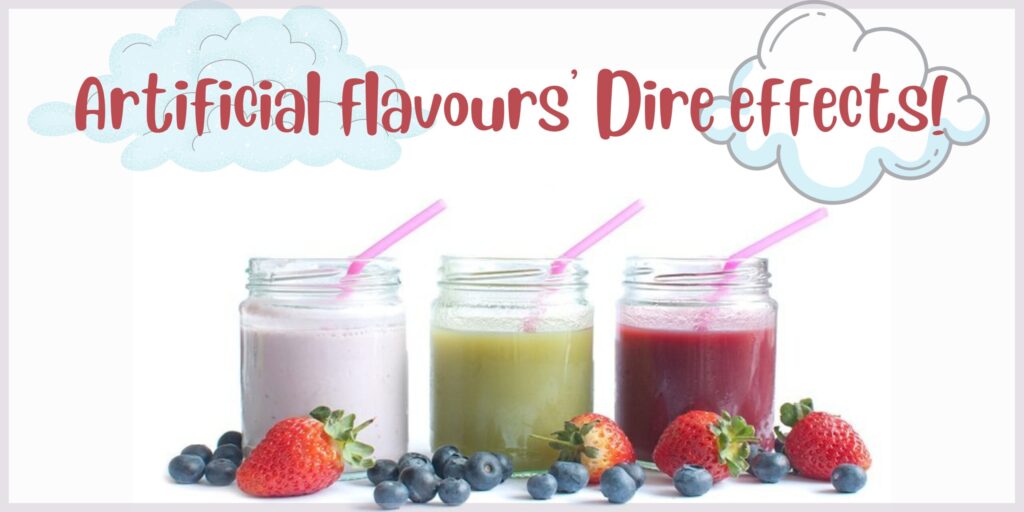Artificial flavours
The side effects of artificial flavours are pointed out to the fullest extent in this article. Most of the time, food flavours and colours are used to improve the basic chemical characteristics of foods. Food colourings can start making foods appear more attractive, while food flavours can be used to improve the taste of foods or give bland foods a fresh flavour.
Flavourings are added to food to make it taste better, like making it sweeter or giving it a new taste. Food flavourings can also help keep food fresh for a long time, and they can be either natural or made in a lab.
Flavourings don’t add any nutritional value to the food, and some of them can even be harmful. Especially smoked foods are thought to cause cancer, but people like them because of their taste.
A lot of individuals are concerned about the safety and possible health threats of today’s food additives. People talk a lot about how it affects children’s growth and habits in specific.
Outcomes of using artificial flavours
Any pigment, dyestuff, or other chemical component applied to a food item in order to modify or improve its colour is known as a food colouring. They may be used in foods, beverages, and pharmaceuticals. Food colourings are used to improve the appearance of meals as well as to fit customer expectations of how a product should taste.
Artificial sweeteners enjoy hanging out in your stomach. A study revealed that routine utilisation of artificial sweeteners such as saccharin, sucralose, and aspartame resulted in an unusual combination of bacteria in the gut. This elevated the hazard of insulin imbalance, which is the first step toward diabetes and excess weight.
Using artificial sweeteners can make you eat too much is one of the side effects of artificial flavours. Have you ever noticed that when you consume a diet soda with food, you eat more than you usually would or want more food after the meal? Even though they aren’t real sugar, artificial sweeteners still turn on our sweet taste receptors and raise insulin concentrations in the same manner as sugar.
Consequences of artificial flavours
According to studies, there is a relationship between a food’s taste and its predicted colour, and the colour might impact perceptions during ingestion. Natural, artificial, or nature-identical food colourings are used.
The side effects of artificial flavours include some artificial sweeteners having calories, so be careful. Artificial sweeteners could be either non-nutritive or nutritive, but many fall into the non-nutritive category.
Allergic responses and food hypersensitivity, exacerbation of asthmatic symptoms, stomach discomfort, diarrhoea, and vomiting are some of the health hazards associated with the intake of artificial food additives.
Artificial sweeteners might have a negative influence on your brain. Some evidence shows that artificial sweeteners pass the blood-brain barrier and alter hippocampus function when consumed. This reduces sensitivity to interoceptive cues, causes dysregulating appetitive behaviour, and promotes food intake.
Artificial sweetener investigation is divided, but if you’re fit, you may be able to get away with using them. Non-nutritive sweetener usage has been linked to health problems like cancer, weight gain, diabetes, and dental health, according to studies.
Repercussions of artificial flavours
There could be a connection between artificial sweeteners and a number of Gastrointestinal problems, which is one of the side effects of artificial flavours. Gut dysbiosis, which is frequently linked to irritable bowel syndrome (IBS), is quite prevalent. It not only causes bloating and pain in the abdomen, but it also makes it harder to receive the most nutrients from our meal, hurts the wellness of our immune system, and raises the likelihood of a number of long-term inflammatory abnormalities.
A series of food colourings known as azo-dyes, often employed to provide brilliant hues to edible items, has recently gotten a lot of attention. Following ingestion, the chemical compounds in azo-dyes are metabolised by intestinal bacteria in a series of processes, resulting in possibly carcinogenic chemicals.
However, therapeutic effects are dependent on the quantity of colouring consumed, which is often insignificant because azo-dyes are poorly absorbed into the bloodstream. However, due to their capacity to bind to human serum albumin, new health risks have been discovered in using some colourants.



